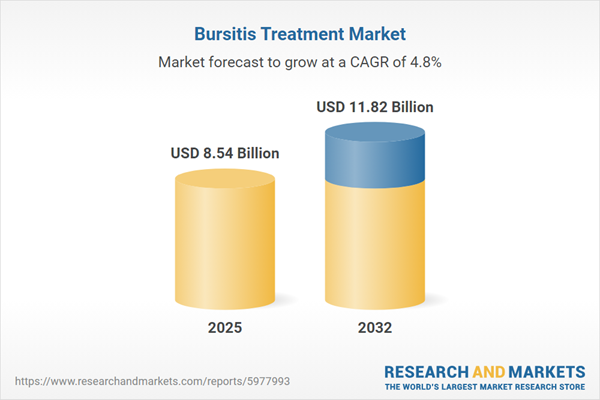Speak directly to the analyst to clarify any post sales queries you may have.
The bursitis treatment market is evolving as healthcare organizations address convergence in technology, regulation, and care delivery. Senior executives recognize the importance of agile strategies and innovation to maintain competitive advantage in a complex landscape.
Market Snapshot: Bursitis Treatment Market Growth and Outlook
The bursitis treatment market, valued at USD 8.14 billion in 2024, is poised for steady expansion with a projected compound annual growth rate (CAGR) of 4.77%. Forecasts indicate the market will reach USD 8.54 billion in 2025 and USD 11.82 billion by 2032, reflecting resilience and rising adoption of advanced solutions. Growth is underpinned by increased investment in newer therapies, incorporation of emerging clinical models, and a shift toward patient-centered care. Competitors are refining their portfolios and operational approaches in response to evolving market dynamics. Organizations that proactively adapt and implement forward-thinking practices are set to secure stronger market positions amid ongoing changes.
Bursitis Treatment Market Scope & Segmentation
- Treatment Types: Includes home-based ice therapy, immobilization, injectable solutions such as corticosteroids and platelet-rich plasma, hyaluronic acid options, anti-inflammatory drugs, physical therapy for mobility, and tailored surgical interventions for more severe needs.
- Product Categories: Covers antibiotic therapies, biologics, corticosteroids, and NSAIDs, all integrated with healthcare technology systems. This supports strategic procurement decisions and targeted research initiatives.
- Application Sites: Addresses bursitis affecting the elbow, heel, hip, knee, and shoulder, supporting precise solutions for distinct patient demographics and increasing clinical relevancy through targeted offerings.
- End Users: Serves hospitals, orthopedic and sports medicine centers, ambulatory surgical facilities, and in-home care providers, allowing for broad service reach and diverse patient engagement across varied care settings.
- Regional Coverage: Analyzes market and regulatory frameworks across the Americas (including the U.S., Canada, Mexico, and South America), Europe, Middle East & Africa, and Asia-Pacific, supporting strategies for localized product adaptation and effective market entry.
- Key Companies Analyzed: Reviews advancements and innovation from leaders including Pfizer Inc., Bayer AG, Johnson & Johnson, Novartis AG, Teva Pharmaceutical Industries Ltd., GlaxoSmithKline plc, Sanofi S.A., Merck & Co., Zimmer Biomet Holdings, and Stryker Corporation, providing benchmarks for executive leadership and technology adoption.
Key Takeaways for Senior Decision-Makers
- Integrated pharmaceutical and biologic solutions, when embedded in cohesive care pathways, foster patient engagement and support the move to value-based care models.
- Adoption of telehealth and wearable monitoring technologies extends service access, facilitates operational data utilization, and promotes smoother workflows across settings.
- Responsive strategies to adjust for regulatory changes and reimbursement policies nurture business flexibility and operational resilience in varying international markets.
- Increasing demand for minimally invasive and regenerative solutions guides ongoing updates in clinical standards and strengthens competitive positioning within the market.
- Enhanced collaboration across orthopedic clinicians, technology partners, and rehabilitation specialists supports coordinated care and drives more comprehensive management of patient needs.
Tariff Impact on Supply Chain and Cost Structure
New tariffs on medical components and pharmaceuticals, commencing in 2025, will alter the bursitis treatment supply chain. Executive teams are responding through expanded local sourcing, enhanced cost management, group purchasing alliances, and investment in digital inventory platforms. These strategies aim to ensure business stability and operational continuity, even in changing trade environments.
Methodology & Data Sources
This report draws on interviews with orthopedic industry leaders, peer-reviewed literature, reviews of regulatory documentation, and analysis of industry whitepapers. Expert validation and analytical models were used to confirm market findings and ensure reliability for executive business decision-making.
Why This Report Matters
- Enables benchmarking and informed strategic refinement as industry frameworks and care models advance and adapt.
- Supports precise procurement and compliance through rigorous segmentation and market clarity.
- Empowers executive teams with current insights into technology adoption, shifting patient needs, and innovation trends shaping the bursitis treatment sector.
Conclusion
Comprehensive segmentation and actionable market intelligence equip decision-makers to enhance resilience, guide strategy, and capture opportunities in the evolving bursitis treatment landscape.
Additional Product Information:
- Purchase of this report includes 1 year online access with quarterly updates.
- This report can be updated on request. Please contact our Customer Experience team using the Ask a Question widget on our website.
Table of Contents
3. Executive Summary
4. Market Overview
7. Cumulative Impact of Artificial Intelligence 2025
Companies Mentioned
The companies profiled in this Bursitis Treatment market report include:- Pfizer Inc.
- Bayer AG
- Johnson & Johnson
- Novartis AG
- Teva Pharmaceutical Industries Ltd.
- GlaxoSmithKline plc
- Sanofi S.A.
- Merck & Co., Inc.
- Zimmer Biomet Holdings, Inc.
- Stryker Corporation
Table Information
| Report Attribute | Details |
|---|---|
| No. of Pages | 186 |
| Published | October 2025 |
| Forecast Period | 2025 - 2032 |
| Estimated Market Value ( USD | $ 8.54 Billion |
| Forecasted Market Value ( USD | $ 11.82 Billion |
| Compound Annual Growth Rate | 4.7% |
| Regions Covered | Global |
| No. of Companies Mentioned | 11 |









